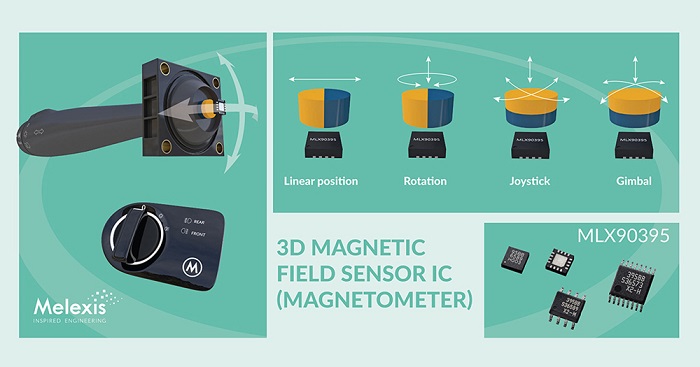By Gina Roos, editor-in-chief
Melexis has launched the MLX90395 Triaxis Magnetometer Node, an automotive-grade (AEC-Q100) Hall-effect sensor that provides contactless sensing in three dimensions. The dual-die version provides redundancy for demanding applications, such as gear lever position sensing in automotive applications, said Melexis.
The MLX90395 offers both I2C and SPI interfaces, making it easy to integrate into an automotive or industrial control environment. The sensor’s functionality is defined via the system processor instead of hardwired into the device itself. Operational modes can be defined and selected at runtime through these interfaces, allowing multiple sensors to form part of a sensor cluster, controlled by a single microcontroller.
The selectable digital output provides 16-bit resolution for X, Y, and Z magnetic field measurements. This enables the host processor, DSP, microcontroller, or digital signal controller to decode the absolute position of any magnet as it passes the sensor, said Melexis.

Both medium-field (50-mT) and high-field (120-mT) versions are available in three package options: SOIC-8, TSSOP-16 (dual-die for redundancy), and QFN-16 (with wettable flanks). All package options are qualified to AEC-Q100 covering the extended temperature range for −40°C to 125°C and are RoHS-compliant.
The MLX90395 is smaller and more power-efficient than alternative Hall-effect sensors, thanks in large part to Melexis’s Triaxis technology, said the company, which enables low power consumption: an idle current of 1.4 μA, a standby current of 2.4 μA, and supply current of 4 mA or less.
The MLX90395 also integrates a temperature sensor and supply voltage monitor. The sensor features three state machines and operates in one of three modes: single measurement, burst mode, and wake-up-on-change mode. Engineers can select which magnetic field is measured and the frequency of measurement to fine-tune the sensor’s energy efficiency as well as the filtering and sampling time to optimize noise versus bandwidth, said Melexis.
Each sensor has a unique 48-bit ID number and contains additional free space to store customer traceability information.
Advertisement
Learn more about Electronic Products Magazine





